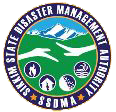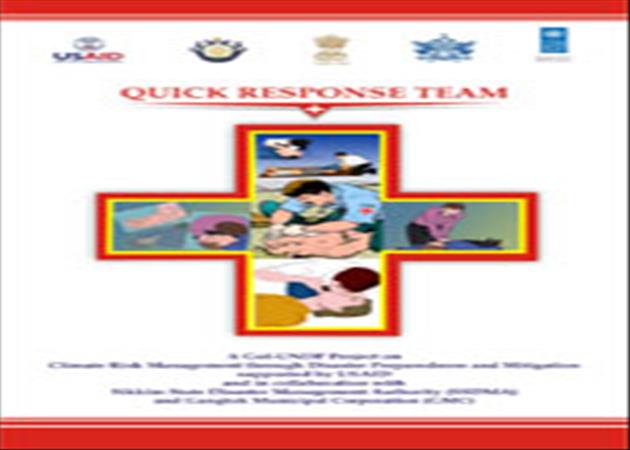Alert
- Fire takes just a second, Practice fire safety today..
- Earthquake do not Kill. Unsafe buildings do.
- covid19 in Sikkim at www.covid19sikkim.org/
The Land Revenue Department is primarily concerned with Revenue Administration in the state which encompasses survey and settlement operation, maintenance and up gradation of land records and enforcement of land laws of the state. With New nomenclature of the Land Revenue & Disaster Management Department there has been a paradigm shift in the management of disasters at all levels, from a Relief Centric Response to disaster preparedness, mitigation and prevention. The enactment of Disaster Management Act 2005 provides greater impetus to the institutionalization of disaster management at state and district levels.
Sikkim State Disaster Management Authority (SSDMA) is a part of State Government and is a nodal institution for planning, co-ordination and monitoring for disaster prevention, mitigation, preparedness and management. SSDMA lays down policies on disaster management for the state. It approves disaster management plan in accordance to the guidelines laid down by National Authority and co-ordinates its implementation. It provides guidelines and reviews the measures being taken for mitigation, capacity building and preparedness by the Government and issue guidelines as necessary. SSDMA recommends provision of funds for mitigation and preparedness measures.
- In case you have to evacuate, do so immediately. Do not try to collect belongings. Landslides can occur suddenly
- When you see falling rocks, seek cover behind trees and other solid objects.
- Landslides, as a result of ground shaking, can create a large volume of mud flow along the slope into the valley. Therefore, do not move in the direction of the valley if you are requested to evacuate, move to elevated areas.
- If escaping is not possible, seek shelter, curl into a tight ball and protect your head.
What is a
landslide?
The term “landslide” (or landslip) describes the downward
movement of rock, earth or debris due to gravity, especially aggravated during the
rainy season.
What causes a landslide?
There are various reasons for
occurrence of landslides. Landslides are usually caused by
human activities that disru the area. Landslides also occur during volcanic
eruions, earthquakes, and waves.
However, landslide are
categorized into two :-
Ø There are various reason why a landslide may occur. Natural
reasons include earthquakes and heavy rainfall. Human causes include mining
operations that use blasting and cNatural causes
Ø Man made causesMMan made causes
Natural causes
Ø Intense rainfall will raise the ground water table,
decrease the soil’s coherence and increase the weight of associated materials.
Ø Lowering of the water levels in rivers, reservoirs, etc.
Ø Erosion caused by continuous run off over a slope.
Ø Deposition of the loose sediments in a delta area.
Ø Decomposition of rocks.
Ø Fluctuation of water levels due to tidal action.
Ø Ground vibration creating during an earthquake.
Ø Volcanic activity.
Man Made Causes
Ø Constructions done without proper engineering inputs.
Ø Farming practices.
Ø Removal of vegetation cover and deforestation
Consequences
of Landslides.
Direct
Losses
Ø
Loss of life:
Landslides can result in death and
injury of people and animals. The moving mass can bury people and animals under
debris.
Ø
Loss of
property and assets: The force and
speed of debris, mud or earth mass generated due to mass movement may destroy
houses, buildings and other properties in its path.
Ø
Loss of
infrastructure and lifeline facilities: Earth mass can block or damage infrastructures such as roads, railway,
bridges, telecommunication and electrical supply lines, etc.
Ø
Loss of
resources: Earth mass can
affect water resources in the area by blocking rivers, diverting water ways, blocking
irrigation channels, reducing storage capacity of tanks and reservoirs, etc.
Ø
Loss of
farmland: Productive lands such as paddy and
other crop fields may be covered with debris or blocked from access.
Ø
Loss of
places with cultural importance
Indirect losses
Ø
Loss in
productivity of agricultural or forest lands: It is due to being buried by debris and lack of access.
Ø
Reduced
property values: Due to
unwillingness of people to purchase disaster prone land.
Ø
Loss of
revenue: Due to loss of productivity, transport
problems, etc.
Ø
Increased
cost: Due to investments in preventing or
mitigating future landslide damage.
Ø
Adverse
effect on water quality: Water
sources may be contaminated.
Ø
Loss of human
productivity: Due to death
and injury.
Ø
Reduction in
quality of life: Due to death of
family members and destruction of personal belongings.
Ø
Impacts on
emotional wellbeing
Do's and Don'ts:
Before
Ø
Listen to
weather forecast on the radio, TV etc. about heavy rains.
Ø
Observe unusual
signs such as appearance of cracks and their rapid expansion over the slope.
Ø
Move away and
inform elders when such signs are recognized
Ø
Remain awake
during nights of heavy continuous rain and be ready to move to a safer
location.
Ø
Listen for
abnormal sounds of soil and rock movement or breaking of trees. They may
be associated with landslide movements.
Ø
Prepare safe
water facilities (covered with a lid).
Ø
Prepare first
aid facilities.
During
After
Ø
Remember: One
slide can follow another. Be careful and stay in a safe place.
Ø
Help people who
need help.
Ø
Use the
telephone only for emergency calls.
Ø
Do not go
through the loose and new deposits of debris. You might sink in or cause more
sliding.




















